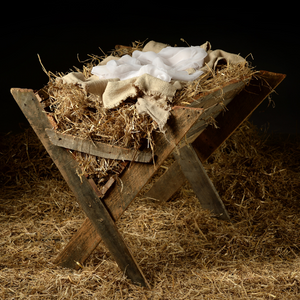When my children were small, I sometimes worried about placing an emphasis on Santa, even as we celebrated Christ. What if, I worried, when the time came when they would see the truth about the North Pole they would also apply the same reasoning to Bethlehem? Still, every Christmas Eve after church we would lay out cookies and milk for Santa and a carrot for his reindeer. As soon as we were sure the kids were asleep, we would eat the cookies, down the milk, put the carrot back in the fridge, and sprinkle some ash around the hearth. It was great fun to see our children’s delight as they bounded down the stairs squealing excitedly at the “evidence” of Santa’s coming. Then, before opening gifts, we would pray to Jesus, thanking him for the blessings he had given us and recognizing his sacred birthday. Eventually, my children ditched the North Pole, but, thankfully, their steadfast recognition of Bethlehem remains.
Two Camps Among Christians
Though all sincere Christians agree on the “Reason for the Christmas season,” there are clearly two camps among Christians when it comes to the subject of Santa and secular Christmas traditions. One camp says Santa should be spurned lest the true reason for Christmas be lost. The other says to enjoy the trappings because, despite the unbelief of the world, they point directly to the true meaning and Author of Christmas.
John Piper, who ascribes to the “spurn Santa” camp warns,
If being Jesus-focused is a killjoy for your Christmas, you don’t know him well. My question is this: How could we possibly even think of giving our children a bowl of bland, sugarless porridge, when they are offered the greatest meal in the world? Why would we give them Santa Claus when they can have the incarnation of the Son of God? It is just mind boggling to me that any Christian would even contemplate such a trade: that we would divert attention away from the incarnation of the God of the universe into this world to save us and our children. I scarcely have words for it that people would contemplate this. Not only is Santa Claus not true and Jesus is very truth himself, but compared to Jesus, Santa is simply pitiful and our kids should be helped to see this.
 Trevin Wax, a contemporary of Piper on The Gospel Coalition, represents the other camp. Wax loves all things Christmas, and unapologetically engages all the traditions, secular and sacred. He wrote recently,
Trevin Wax, a contemporary of Piper on The Gospel Coalition, represents the other camp. Wax loves all things Christmas, and unapologetically engages all the traditions, secular and sacred. He wrote recently,
So, when I hear about the danger of enjoying the extraneous elements of the Christmas season, it sounds a little like a grumpy grandmother telling you to cut out all the sweets in case you lose your appetite for the turkey and ham. Even those who advocate a purely secular holiday season—shorn of religious overtones—cannot change the reality that our society bears the imprint of the birth of Jesus. He is the reason for the season, whether he is recognized or not, or even named. You can change AD Anno Domini, “the year of our Lord”) to CE (common era), but the calendar still starts with the angel’s song, and still testifies to the God-man who came from backwater Galilee. His influence persists.
So who is right? And what can parents do to ensure their children will be able to confidently answer the Grinch’s introspection, “What if Christmas doesn’t come from a store? What if Christmas, perhaps, means a little bit more?”
Celebrations as Beacons
 Santa or no Santa, a Christian parent bears the responsibility to teach their children the Christmas/Easter connection, that is to say, the gospel connection, and to teach it daily, not just on the holidays. So when Christmas (and Easter) rolls around, there is no question about why halls are decked and bells are jingling. Now, more than ever, if our children are going to stick with Jesus, they will be up against the secular tide at every turn. If non-sacred traditions are going to be celebrated, they must be celebrated as beacons whose beams lead directly to the true Light of the World, and lauded, as Wax puts it, as “the fallout from an explosion of glorious joy.” After all, without Christ, there is no Santa, no gifts, no festivities or feasts, no roasting chestnuts or sappy songs about Christmas shoes.
Santa or no Santa, a Christian parent bears the responsibility to teach their children the Christmas/Easter connection, that is to say, the gospel connection, and to teach it daily, not just on the holidays. So when Christmas (and Easter) rolls around, there is no question about why halls are decked and bells are jingling. Now, more than ever, if our children are going to stick with Jesus, they will be up against the secular tide at every turn. If non-sacred traditions are going to be celebrated, they must be celebrated as beacons whose beams lead directly to the true Light of the World, and lauded, as Wax puts it, as “the fallout from an explosion of glorious joy.” After all, without Christ, there is no Santa, no gifts, no festivities or feasts, no roasting chestnuts or sappy songs about Christmas shoes.
When that explosion of joy hits the malls, the TV, and radio stations, let’s teach our children and grandchildren the Origin of it all. Let’s focus on the common, emotion-provoking thread that runs through Christmas concerts, beer commercials, holiday movies, and all manner of Christmas music: our love for Jesus Christ. Here are four attributes of Christmas that serve to help our children focus attention on the connection to Christ.
Jesus is the beauty of Christmas.
“One thing have I asked of the Lord, that will I seek after: that I may dwell in the house of the Lord all the days of my life, to gaze upon the beauty of the Lord and to inquire in his temple” (Psalm 27:4). Even the most shocking and marvelous beauty we can behold on this earth, and every beautiful decoration and touching Christmas sentiment that affect us so deeply at Christmastime are but mere reflections of the matchless beauty of Jesus Christ, and illustrative of his deep love of beauty. In fact, Christ is the origin and essence of beauty.
Jesus is the peace of Christmas.
Jesus, in John 16:33, proclaims, “I have said these things to you, that in me you may have peace. In the world you will have tribulation. But take heart; I have overcome the world.” Peace on earth is nothing more than an impracticable hope without Jesus at the center of it. The peace of Christ is so much more than a gentle Christmas scene or the imagery of a mild “Silent Night.” The peace of Christ is a deep, soul-suffusing, unshakable Shalom that will carry us to eternity.
 Jesus is the hope of Christmas.
Jesus is the hope of Christmas.
The secular world often talks about hope. But hope in this context is mere sentiment. The hope of Christmas, that is the hope that lives in us when we embrace the promises of Jesus Christ, is more than just sentiment. It is reality itself, a sure hope that cannot be shaken because it rests in unshakable promises. The psalmist, in Psalm 119:50, declared, “This is my comfort in my affliction, that your promise gives me life.” Only Christ can offer hope through his great promises left to us in the scriptures. Christmas is, as the carol proclaims, where fear and hope meet. It is where we know our future with the King of the Universe is sealed.
Jesus is the joy of Christmas.
Joy, born from love for Christ, is what resonates when we are overcome with emotion at anything from holiday movies, to Christmas tree lightings, to Christmas music on the radio. We are wired to experience the joy of Christmas, because we were created to experience the joy of Christ. We all feel it at this time of year, whether we believe in Jesus or not. But, believe it or not, Jesus Christ is the origin of that warmth, that emotion, that unparalleled sentiment that overtakes us at Christmastime. Jesus Christ truly is Joy to the World.
Whether or not we celebrate Christmas in purely sacred terms, or we delve fully into the secular traditions that mark the season, we can intentionally and winsomely teach our kids that Jesus Christ left the glory of Heaven to condescend to earth. He wrapped himself in vulnerable flesh, submitting himself to the pain and heartache of the human experience. He did this in order to accomplish for us what we cannot: eternal happiness in the heart of our Creator. His love and his grace are boundless.
Dr. Seuss concluded, “Christmas Day will always be, just as long as we have we.” But we Christian parents know better, and we must use all the trappings of Christmas to conclude for our children that Christmas Day will always be as long as we have Christ.
At Dayspring Christian Academy, students are taught Providential history, the view that God is actively involved in every aspect of life, telling His story throughout history for His plans and purposes. Consequently, students learn the rudiments of America’s Christian history, from the time of the Pilgrims to its founding, up to current times. Thinking and reasoning from God’s Word enables students to identify Truth and stand firm in their faith. Dayspring students delve deeply into the timeline of Christian history and arrive at the question, “How will God use me in His story?” To learn more, take a tour. Register online or call Karol Hasting at 717-285-2000.

